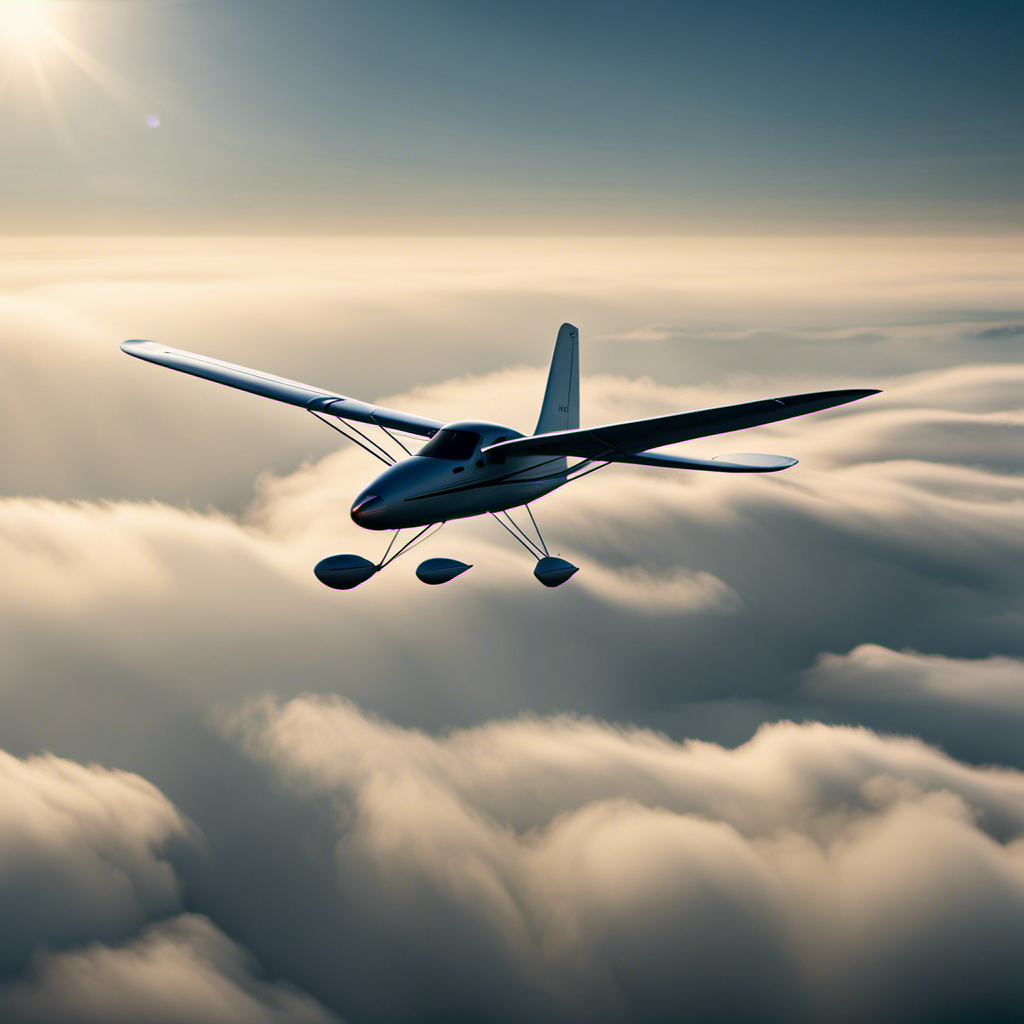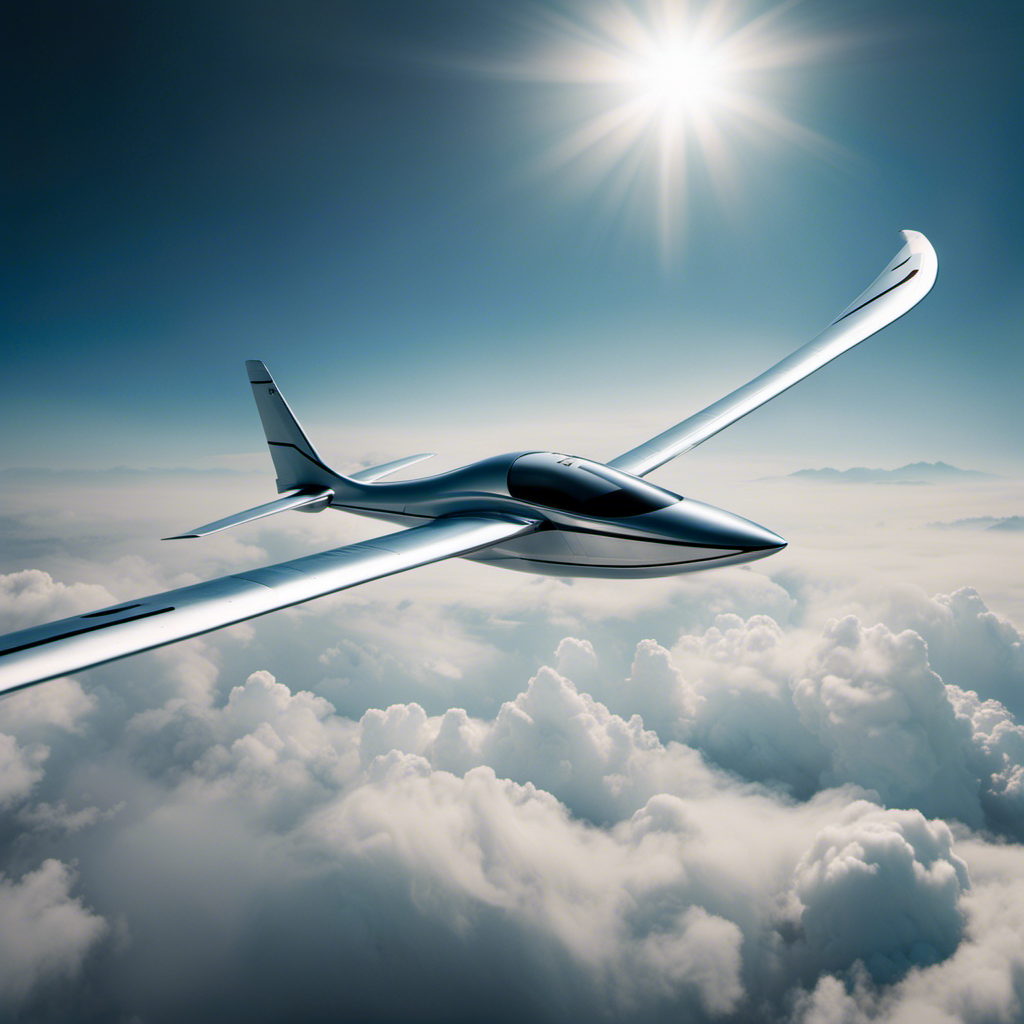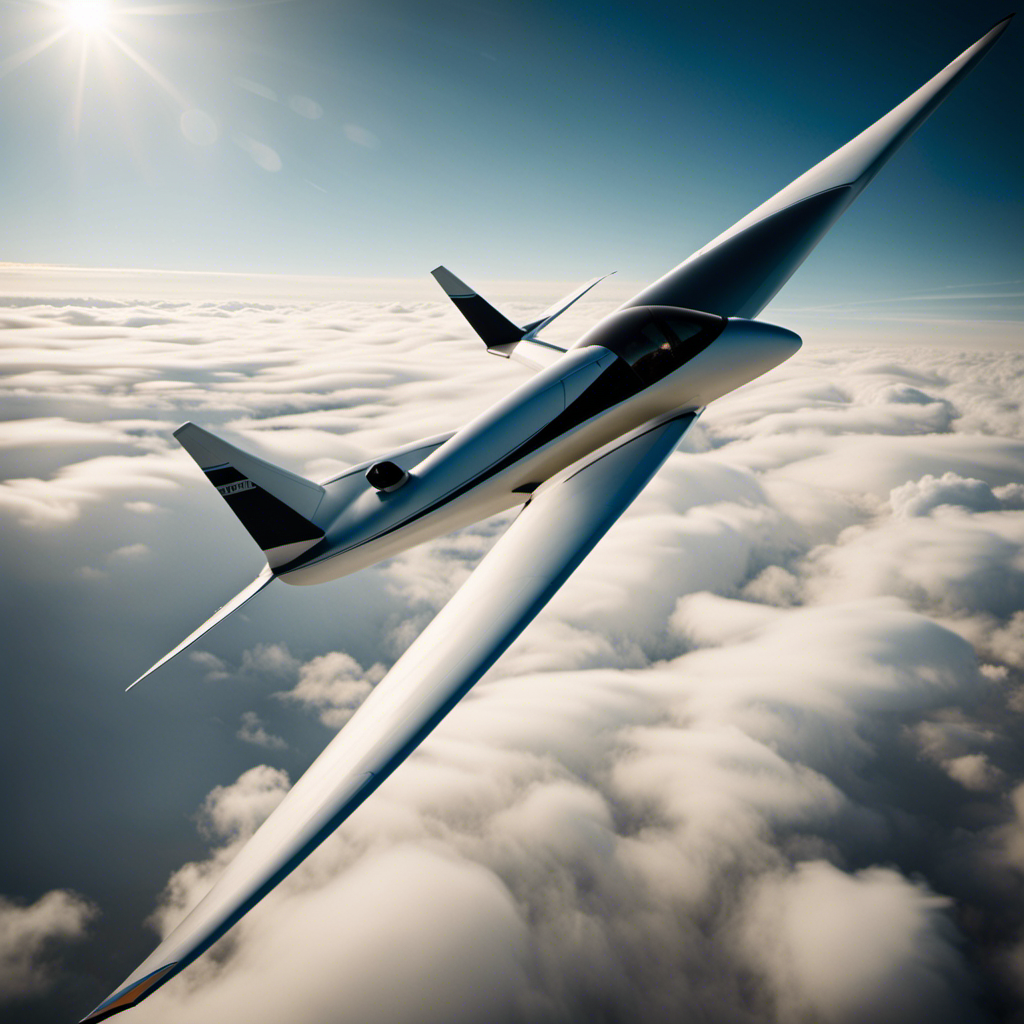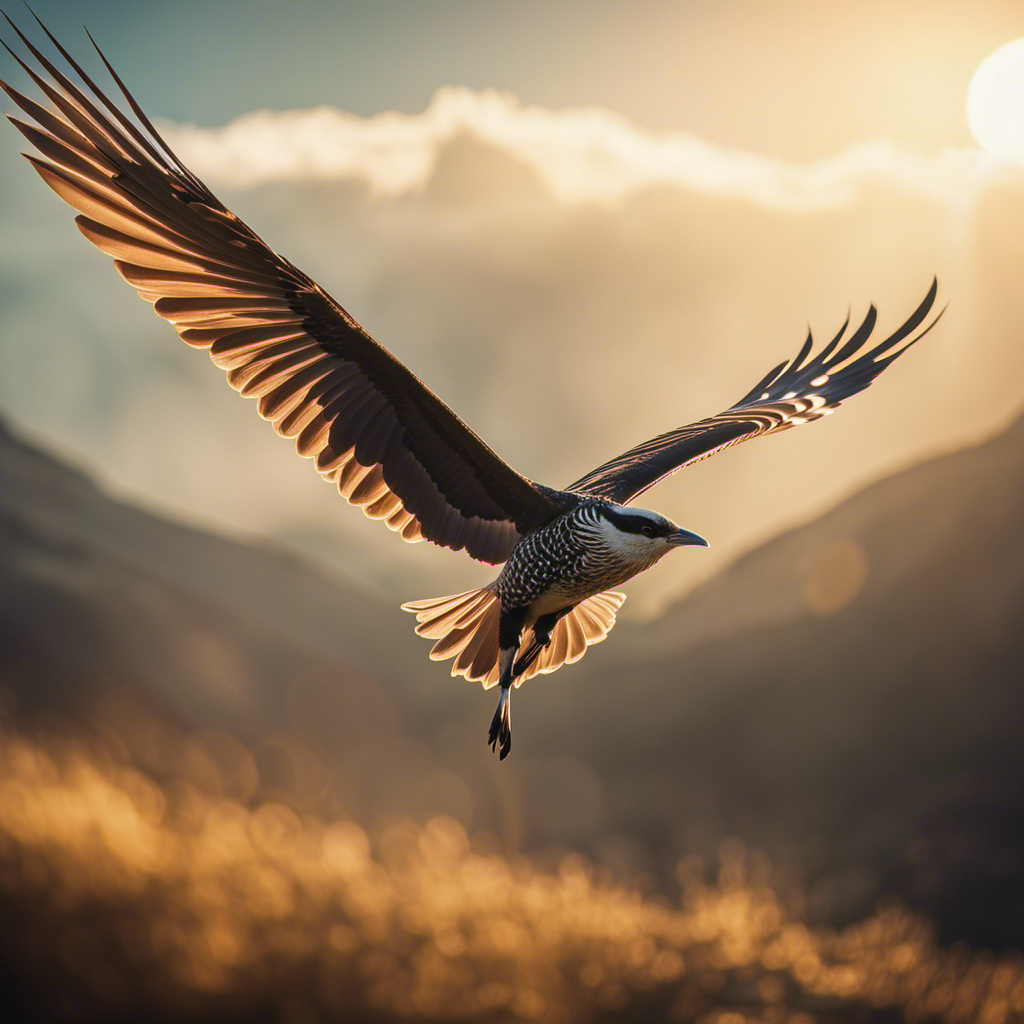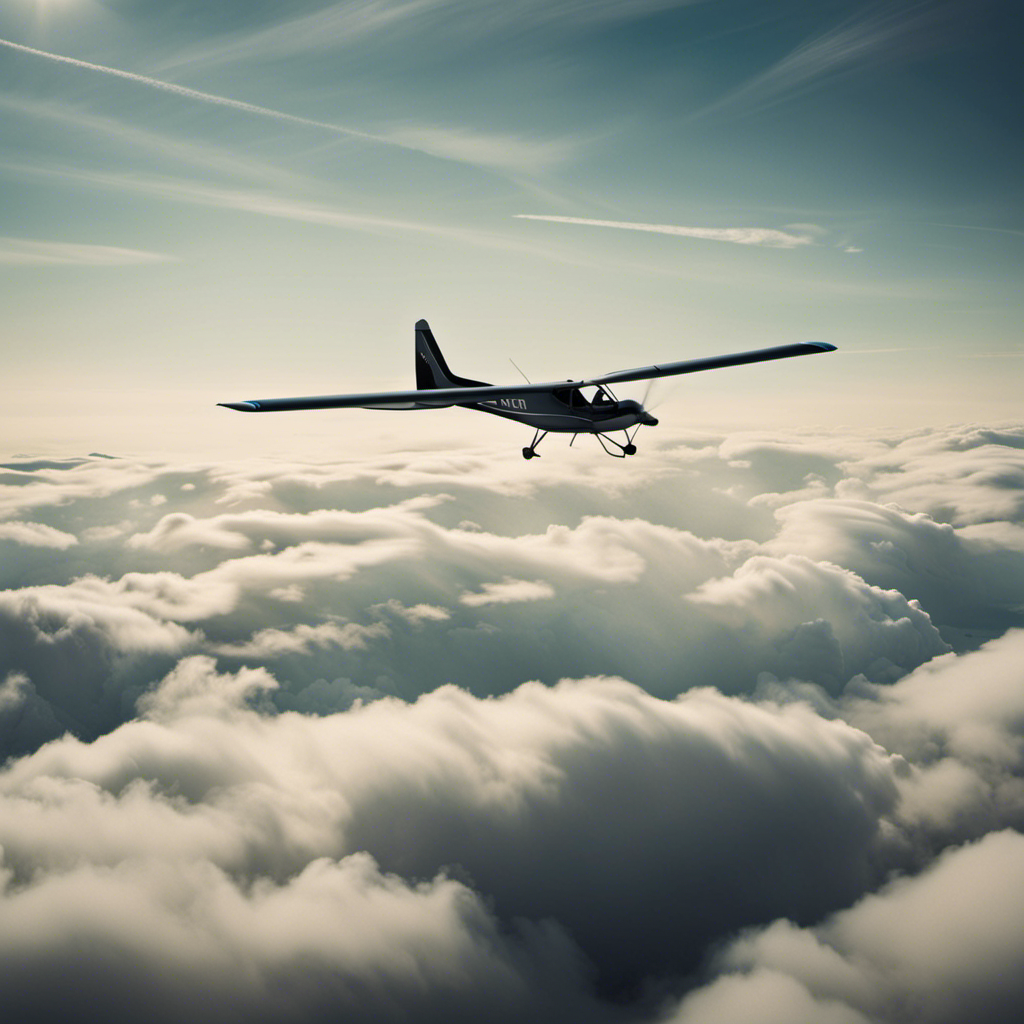As a glider pilot, the elegance of soaring through the sky without the aid of engines has always fascinated me. It’s like using the wind for a beautiful dance, a seamless interaction between the wings and the air.
But how is it possible for gliders to climb to great heights and stay aloft for hours? In this article, we’ll delve into the intricacies of gliding, exploring the science behind their design and the techniques used to harness the power of the atmosphere.
Get ready to be captivated by the world of gliding and discover the secrets of their incredible flight.
Key Takeaways
- Gliders fly high without engines by generating lift through the shape of their wings.
- Gliding techniques involve maximizing lift and minimizing drag.
- Thermals and ridge soaring are used to gain altitude and extend flight time.
- The design of gliders, including wing configuration, wing aspect ratio, wing camber, and wingtip design, plays a crucial role in lift generation and drag reduction.
Understanding the Basics of Gliding
You can understand the basics of gliding by learning how gliders can fly very high without any engines. Gliding is possible because of the concept of lift. Lift is a force that acts perpendicular to the direction of motion and keeps the glider airborne. It is generated by the shape of the glider’s wings, called airfoils. By carefully designing the airfoils, glider manufacturers create maximum lift with minimum drag.
Gliding techniques involve manipulating the glider’s flight path to maximize lift and minimize drag. This includes using thermals, updrafts of warm air, to gain altitude and extend flight time. Another technique is ridge soaring, where the glider uses the upward air currents created by wind hitting a hill or mountain to stay aloft. Understanding lift and employing these gliding techniques allows gliders to soar effortlessly through the sky.
Now, let’s delve into the science behind glider design and explore how it enables their remarkable flight capabilities.
The Science Behind Glider Design
When it comes to designing a glider, there are several key factors that need to be considered.
The first is the aerodynamic shape and wing configuration, which play a crucial role in maximizing lift and minimizing drag.
Materials and construction also play a vital role in the glider’s performance, as they need to be lightweight, yet strong enough to withstand the forces experienced during flight.
Lastly, controlling the glider’s flight path is essential for achieving optimal performance and safety, requiring precise control surfaces and a skilled pilot.
Overall, these factors are crucial in creating a well-designed glider that can efficiently soar through the air.
Aerodynamic Shape and Wing Configuration
To achieve high altitude flight without engines, gliders rely on an aerodynamic shape and specific wing configuration. The aerodynamic efficiency of a glider is crucial for maximizing lift generation and minimizing drag. Here are four key aspects that contribute to the glider’s ability to soar through the sky:
-
Wing Aspect Ratio: A high aspect ratio, where the wingspan is much greater than the chord length, reduces induced drag and enhances lift production.
-
Wing Camber: The shape of the wing’s upper and lower surfaces, known as camber, helps generate lift by creating pressure differences between the two surfaces.
-
Wingtip Design: The presence of winglets or upturned wingtips reduces the formation of wingtip vortices, decreasing drag and increasing efficiency.
-
Fuselage Design: The streamlined shape of the fuselage minimizes drag and allows for smooth airflow over the aircraft.
By carefully optimizing these aspects, glider designers can create a machine capable of harnessing the power of the air.
As we move on to the next section on materials and construction, it is important to consider how these design choices interact with the physical properties of the glider.
Materials and Construction
The materials used in the construction of gliders play a crucial role in their performance and durability. Advanced materials and structural engineering techniques are employed to ensure the glider’s strength, weight, and aerodynamic properties are optimized.
The main component of a glider is its airframe, which is typically made of lightweight yet strong materials such as carbon fiber composites or fiberglass. These materials offer excellent strength-to-weight ratios, allowing the glider to maintain its structural integrity while minimizing its overall weight.
Additionally, careful attention is given to the design and construction of the wings, which are often built using advanced materials and techniques to ensure optimal lift and reduced drag. By utilizing these advanced materials and construction methods, gliders are able to achieve the high altitudes necessary for sustained flight without engines.
Transitioning to the subsequent section about controlling the glider’s flight path, one important aspect to consider is the role of control surfaces and pilot input.
Controlling the Glider’s Flight Path
One important aspect to consider in controlling a glider’s flight path is the role of control surfaces and the input of the pilot. The control surfaces, such as the ailerons, elevator, and rudder, allow the pilot to manipulate the glider’s attitude and direction. By making precise adjustments to these control surfaces, the pilot can effectively steer the glider and maintain its desired flight path.
In addition to control surfaces, the glider’s flight path is also influenced by external factors such as thermals and updrafts. Thermals are columns of rising warm air, and updrafts are upward currents of air caused by the terrain or weather conditions. By strategically navigating through these thermals and updrafts, the pilot can gain altitude and extend the flight time of the glider.
Harnessing the Power of the Atmosphere
You can harness the power of the atmosphere to help gliders fly very high without any engines. Atmospheric dynamics play a crucial role in glider flight, and one technique that takes advantage of these dynamics is thermal soaring.
Thermals are pockets of warm air that rise from the Earth’s surface due to heating from the sun. As a glider pilot, I am constantly scanning the sky for signs of thermal activity. When I find a thermal, I maneuver the glider into it and ride the updraft, gaining altitude without the need for an engine. This technique requires precise control and skill, as thermals can be unpredictable and vary in strength.
By understanding the atmospheric dynamics and effectively utilizing thermal soaring, gliders can achieve impressive altitudes and stay airborne for extended periods of time.
Transitioning to the next section, the role of the pilot in glider flight is crucial for maximizing performance and safely navigating the skies.
The Role of the Pilot in Glider Flight
When it comes to glider flight, the pilot plays a crucial role in ensuring a safe and successful journey. Skillful navigation and decision making are essential in order to navigate through the ever-changing atmospheric conditions and find the most favorable areas of lift.
Utilizing instruments and technology, such as variometers and GPS systems, can greatly assist the pilot in making accurate decisions and maximizing the glider’s performance.
Additionally, knowledge of safety and emergency procedures is of utmost importance to handle unexpected situations and ensure the well-being of both the pilot and the glider.
Skillful Navigation and Decision Making
Gliders can reach high altitudes through skillful navigation and decision making. When flying without an engine, pilots rely on their expertise to make the right choices and navigate the skies effectively. This requires a combination of technical skills and analytical thinking.
Here are three ways in which skillful navigation and decision making contribute to successful glider flights:
-
Careful assessment of weather conditions: Pilots must analyze the current weather patterns and make informed decisions on when and where to fly. This involves observing wind directions, cloud formations, and other atmospheric factors.
-
Strategic route planning: By studying topographic maps and understanding the local geography, pilots can identify areas with favorable wind patterns and potential sources of lift. They can then plan their flight routes accordingly to optimize altitude gain.
-
Adapting to changing conditions: Glider pilots must constantly monitor their surroundings and be prepared to adjust their flight plans as conditions evolve. This requires quick thinking and the ability to make split-second decisions to ensure safety and maximize performance.
Utilizing Instruments and Technology
Utilizing instruments and technology enhances my flying experience in gliders. By incorporating advanced instruments like variometers and GPS systems, I gather crucial information about altitude, speed, and position. This enables me to make informed decisions and navigate more efficiently.
The variometer provides real-time feedback on vertical speed, helping me locate thermals, areas of rising air essential for gaining altitude. The GPS system offers accurate navigation and mapping capabilities, ensuring I stay on course and avoid airspace restrictions. These technological advancements greatly enhance my situational awareness and flight performance.
Moving on to safety and emergency procedures, it is vital to recognize that these instruments also play a crucial role in ensuring a safe and secure flight.
Safety and Emergency Procedures
To ensure your safety in the event of an emergency, it is important to familiarize yourself with the proper procedures and equipment.
One of the most critical aspects of glider safety is being prepared for an emergency landing. In the unfortunate event that you need to perform an emergency landing, there are specific steps to follow to increase your chances of a successful outcome. These steps include selecting a suitable landing area, maintaining a proper glide ratio, and preparing for touchdown.
Additionally, regular equipment maintenance is essential to ensure the safety of both the pilot and the glider. This includes inspections of the aircraft’s structure, control systems, and emergency equipment.
By adhering to these procedures and properly maintaining the equipment, you can minimize the risks associated with gliding and be better prepared for any emergency situation.
Transitioning into the next section, let’s now explore the exciting world of gliding competitions and records.
Gliding Competitions and Records
Competitors in gliding competitions aim to break records by soaring to incredible heights using only the power of the wind. To achieve these remarkable altitudes, gliders employ various gliding techniques and strategies for maximizing altitude.
One key technique is called thermaling, which involves circling within rising columns of warm air called thermals. By using thermals effectively, pilots can gain altitude and stay aloft for extended periods.
Additionally, ridge soaring is another technique commonly used in gliding competitions. This technique involves flying along the ridge of a hill or mountain, where the wind is forced upward, providing lift.
Competitors carefully study weather patterns, wind direction, and terrain to identify the most favorable conditions for maximizing altitude.
By utilizing these gliding techniques and strategies, competitors are constantly pushing the boundaries of glider performance and reaching new heights.
As we look towards the future of gliding, advancements in technology and aerodynamics will further enhance glider capabilities, allowing for even higher altitudes and more impressive records to be achieved.
The Future of Gliding
As we look ahead, advancements in technology and aerodynamics will continue to enhance glider capabilities, allowing for even greater altitudes and more impressive records to be achieved. One area that holds great potential is the role of AI in gliding.
Artificial intelligence can assist glider pilots in making real-time decisions by analyzing vast amounts of data, such as weather patterns and air currents. This can lead to more efficient routes and improved performance. Furthermore, AI can contribute to environmental sustainability in gliding by optimizing energy usage and reducing carbon emissions.
For example, AI algorithms can help glider pilots find thermals more effectively, minimizing the need for motorized assistance. With these advancements, the future of gliding looks promising, with increased efficiency, reduced environmental impact, and even safer operations.
Speaking of safety, let’s now explore the crucial aspects of gliding safety and training.
Gliding Safety and Training
One important aspect of gliding safety and training is the proper understanding and execution of emergency procedures. In order to ensure a safe gliding experience, it is crucial to have a thorough knowledge of what to do in case of emergencies. Here are five key emergency procedures that every glider pilot should be familiar with:
- Emergency landings: Pilots must know how to identify suitable landing spots and execute emergency landings safely.
- Stall recovery: Understanding how to recover from a stall is crucial for maintaining control of the glider in critical situations.
- Rope break procedures: In the event of a rope break during launch, pilots must know how to safely release from the tow rope and land without power.
- Canopy jettison: If the canopy becomes jammed, pilots must be able to quickly jettison it to exit the glider in an emergency.
- Glider maintenance: Regular maintenance and inspections are essential to ensure the glider is in optimal condition for safe flying.
By mastering these emergency procedures and maintaining the glider properly, pilots can mitigate potential risks and enhance their safety during flights.
Now, let’s explore the vibrant world of gliding clubs and communities.
Gliding Clubs and Communities
Joining a gliding club offers numerous benefits for enthusiasts like me. Firstly, membership provides access to a wide range of gliders and equipment, allowing for continuous skill development and exploration of various models.
Additionally, being part of a gliding club opens up opportunities for social interactions and networking with fellow glider pilots, creating a supportive and collaborative community that shares a common passion for soaring through the skies.
Joining a Gliding Club
If you’re interested in gliding, you should consider joining a gliding club. Being a part of a gliding club not only allows you to connect with fellow glider enthusiasts but also provides you with access to resources and knowledge that can enhance your gliding experience.
Glider maintenance is a crucial aspect of being a glider pilot. By joining a gliding club, you can learn about the proper maintenance techniques and procedures to keep your glider in top condition.
Additionally, glider aerodynamics is another important area of knowledge for glider pilots. Understanding the principles of aerodynamics can help you navigate the skies more efficiently and maximize your gliding performance.
Benefits of Membership
Being a member of a gliding club offers numerous benefits. One of these benefits is access to resources and knowledge that can enhance your gliding experience. As a member, you gain access to a wide range of resources that can help you improve your skills and knowledge about gliding. These resources include training materials, flight simulators, and expert guidance from experienced pilots.
Additionally, membership in a gliding club allows you to engage with a community of like-minded individuals who share your passion for gliding. This community engagement provides opportunities for collaboration, learning, and support from fellow members. Some key benefits of membership include:
- Access to training materials and resources
- Guidance from experienced pilots
- Networking opportunities with other gliding enthusiasts
- Community events and activities that foster a sense of belonging and camaraderie
By being a member of a gliding club, you not only enhance your gliding skills but also become part of a vibrant community that shares your love for the sport. This community engagement is invaluable in fostering personal growth and a deeper connection to the world of gliding.
Moving forward, let’s explore the social and networking opportunities that membership in a gliding club can offer.
Social and Networking Opportunities
As a member of a gliding club, you’ll have the chance to connect with other enthusiasts and build a strong network of like-minded individuals. This network will be invaluable in expanding your knowledge and opportunities in the gliding community.
Gliding clubs often organize networking events where you can meet experienced gliders, instructors, and even potential employers. These events provide a platform for exchanging ideas, learning from others’ experiences, and exploring career opportunities in gliding.
Through these interactions, you can gain valuable insights into different aspects of the gliding industry, such as aerodynamics, meteorology, and maintenance. By building connections and attending networking events, you’ll be well-positioned to discover exciting career paths and further enhance your skills in the gliding world.
Now, let’s explore some of the breathtaking gliding destinations and experiences that await you.
Gliding Destinations and Experiences
Gliding destinations offer incredible experiences for those who love to fly without engines. As a glider pilot, I’ve had the privilege of exploring some of the most breathtaking locations around the world. Here are four reasons why glider tourism provides extreme gliding experiences:
-
Thermals: Gliding destinations are carefully selected for their optimal thermal conditions. These rising columns of warm air allow gliders to gain altitude and stay airborne for extended periods.
-
Ridge Soaring: Certain destinations boast majestic mountain ranges that create ideal conditions for ridge soaring. Gliders can harness the power of strong winds that flow up the slopes, enabling them to soar along the ridges with ease.
-
Wave Lift: In some regions, gliders can take advantage of wave lift created by the interaction of strong winds with mountainous terrain. This phenomenon allows gliders to reach extraordinary altitudes and experience unparalleled views.
-
Dynamic Soaring: Coastal locations with consistent sea breezes provide opportunities for dynamic soaring. By skillfully maneuvering between the wind gradient, gliders can gain energy and achieve remarkable speeds.
These gliding destinations offer a unique blend of technical challenges and natural beauty, making them the perfect choice for those seeking extreme gliding experiences.
Now let me share some inspiring stories and personal accounts that showcase the thrill and adventure of glider flying.
Inspiring Stories and Personal Accounts
After exploring the breathtaking gliding destinations and my own exhilarating experiences, it is now time to delve into the inspiring stories and personal accounts of gliding enthusiasts. These narratives offer a glimpse into the sheer joy and fulfillment that gliding can bring. Let me share with you some remarkable tales that showcase the resilience, determination, and awe-inspiring moments that occur in the world of gliding.
| Story | Account |
|---|---|
| Soaring Above the Clouds | As I ascended higher into the sky, leaving the ground behind, a sense of tranquility washed over me. The sight of fluffy white clouds below and the vast expanse of blue above was truly mesmerizing. I felt like I was floating in a dream, completely liberated from the constraints of gravity. It was a humbling experience, reminding me of the boundless possibilities that await us when we embrace the power of the wind. |
| Overcoming Fear | As a novice glider, I was apprehensive about venturing into the unknown. But with the encouragement of my instructor, I mustered the courage to take flight. The initial fear gradually transformed into pure exhilaration as the glider smoothly soared through the air. It was a pivotal moment that taught me the importance of pushing past my comfort zone and embracing new challenges. |
| Chasing the Thermals | One of the most thrilling experiences in gliding is chasing thermals, the invisible updrafts of warm air that allow gliders to gain altitude. The sheer excitement of locating and riding these pockets of rising air is unparalleled. It requires a keen sense of observation, intuition, and a deep connection with the elements. The exhilaration of effortlessly climbing higher and higher with each thermal is a sensation that cannot be replicated. |
These stories and personal experiences serve as a testament to the profound impact gliding can have on individuals. They highlight the sense of freedom, the adrenaline rush, and the sheer beauty of soaring through the sky. Whether it is conquering personal fears, exploring new horizons, or chasing the wind, gliding offers a unique and unforgettable journey for those who seek it.
Frequently Asked Questions
What are some famous gliding destinations around the world?
Some famous gliding destinations around the world include the Alps in Europe, the Andes in South America, and the Great Plains in the United States. Gliding techniques involve utilizing rising air currents and strategic flight paths.
How long does it take to become a certified glider pilot?
To become a certified glider pilot, one must undergo extensive training and meet certain requirements. This includes completing a set number of flight hours, passing written and practical exams, and demonstrating proficiency in various flight maneuvers and safety procedures.
Are there any age restrictions for participating in gliding competitions?
Age restrictions for gliding competitions vary depending on the organization. Generally, participants must be at least 14 years old. Other participation requirements include holding a valid glider pilot license and meeting specific experience and skill criteria.
What are some safety precautions that should be taken during a glider flight?
Safety measures during a glider flight include pre-flight inspections, wearing a parachute, and being aware of weather conditions. Emergency procedures involve knowing how to handle a rope break or a loss of lift.
Can gliders be used for aerial photography or scientific research purposes?
Yes, gliders can be used for aerial surveys and scientific research purposes. Recent glider technology advancements have made them capable of carrying specialized equipment for data collection and photography during flights.
Conclusion
In conclusion, the world of gliding is a captivating one, where the laws of physics and the mastery of atmospheric conditions come together in a perfect symphony of flight. From understanding the basics of gliding to delving into the intricate science behind glider design, we have explored the remarkable ability of these aircraft to soar to unimaginable heights without any engines.
The role of the pilot in harnessing the power of the atmosphere cannot be understated, as they navigate their way through thermals and currents, always striving for that next level of altitude. Gliding competitions and records push the boundaries of what is possible, inspiring us all to dream bigger and reach for the skies.
Safety and training are paramount in this exhilarating sport, ensuring that pilots are well-prepared for the challenges that they may face. Gliding clubs and communities offer a support network and a sense of camaraderie, where enthusiasts come together to share their passion and knowledge.
And finally, gliding destinations and experiences take us to breathtaking heights and offer a unique perspective of the world below. The world of gliding is one of beauty, excitement, and limitless possibilities. So, if you have ever dreamed of soaring through the clouds, embracing the freedom of flight, it’s time to take that leap and discover the incredible world of gliding.
Get ready to have your breath taken away as you reach new heights and experience the true meaning of freedom. Your journey awaits, and the skies are calling.
With a heart that soars as high as the skies, Aria, affectionately known as “Skylark,” is the driving force behind Soaring Skyways. Her journey into the gliding world began as a young dreamer gazing up at the soaring birds, yearning to experience the weightlessness and freedom they embodied. With years of experience both in the cockpit and behind the scenes, Aria’s commitment to the gliding community is unwavering.
